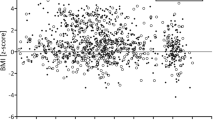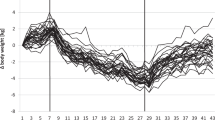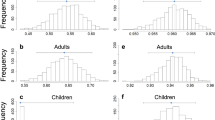Abstract
Objective: To assess the changes in energy intake (EI), food intake volume (FV) and energy density (ED) related to age and gender in a population in the Mediterranean area of Spain, and to determine the different role of FV and ED on the consecution of the adequate EI throughout lifespan.
Subjects: One thousand and eighty-eight individuals (1–65 y) randomly selected from the population census.
Design: Cross-sectional study in which food intake was quantified by 24 h dietary recall, three non-consecutive days. Height and weight measurements were taken in 885 individuals.
Results: EI, FV and ED increased progressively (P<0.001) between 1–2 y and 10–12 y of age in both sexes. At 1–2 y the EI is 5.8±1.5 MJ/d, FV 1195±275 g/d and ED 4.8±0.9 kJ/g. Between 1–2 and 3–4 y, coinciding with an EI that increased up to 7.2±1.5 MJ/d, there was an increase in ED up to 6.1±0.8 kJ/g (P<0.001), while the FV did not vary significantly. At the start of puberty, between 7–9 and 10–12 y, when the EI increased to 9.7±0.9 MJ/d (P<0.001) in males, the ED rose to 7.1±0.9 kJ/g (P<0.001) while the FV did not vary significantly. At this age, a significant difference between the genders was observed in the EI (P=0.04), and in the ED (P=0.02) but not, as yet, in the FV. During adulthood, a significant trend towards decrease (P<0.001 in both sexes) was observed in EI and ED. However, FV decreased significantly only in females.
Conclusions: The changes in energy intake that were observed with respect to age and gender were accommodated-for by changes in the ED of the diet rather than by variations in food volume intake. Auto-regulation of the ED of the diet, sufficient for energy intake requirement changes, appears to be an essential human capacity for efficient nutrition.
Sponsorship: This study was funded, in part, by a grant for B Vizmanos from DANONE, Spain.
This is a preview of subscription content, access via your institution
Access options
Subscribe to this journal
Receive 12 print issues and online access
$259.00 per year
only $21.58 per issue
Buy this article
- Purchase on Springer Link
- Instant access to full article PDF
Prices may be subject to local taxes which are calculated during checkout
Similar content being viewed by others
Author information
Authors and Affiliations
Contributions
Guarantor: Carlos Martí-Henneberg, MD PhD
Contributors: C Martí-Henneberg, V Arija and F Capedevila designed the study, coordinted the field work and wrote the paper. B Vizmanos, S Pérez and G Cucó did the field work and J Fernández-Ballart did the statistical analysis and contributed to the realization of the study.
Rights and permissions
About this article
Cite this article
Martí-Henneberg, C., Capdevila, F., Arija, V. et al. Energy density of the diet, food volume and energy intake by age and sex in a healthy population. Eur J Clin Nutr 53, 421–428 (1999). https://doi.org/10.1038/sj.ejcn.1600770
Received:
Revised:
Accepted:
Published:
Issue Date:
DOI: https://doi.org/10.1038/sj.ejcn.1600770
Keywords
This article is cited by
-
The effect of a low-energy food foam on appetite measures during a 1-day reduced-energy meal plan
International Journal of Obesity (2015)
-
Food price policies improve diet quality while increasing socioeconomic inequalities in nutrition
International Journal of Behavioral Nutrition and Physical Activity (2014)
-
Dietary energy density in young children across Europe
International Journal of Obesity (2014)
-
Healthy eating norms and food consumption
European Journal of Clinical Nutrition (2014)
-
Dietary energy density as a marker of dietary quality in Swedish children and adolescents: the European Youth Heart Study
European Journal of Clinical Nutrition (2010)



